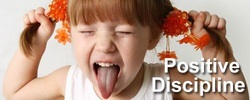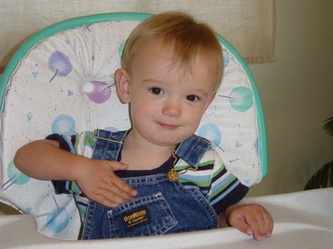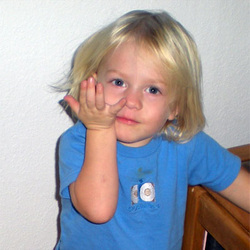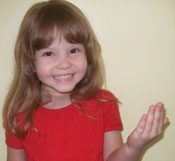Bables by: Me
Bables by: Me, was created to show the world my knowledge in Early Childhood Education also to give myself a place to clearly and freely express my opinions on the subjects I choose related to Early Childhood Education Field. It will also be the place where I share my progress in becoming a Professional in this wonderful field.
Positive Discipline

Discipline? What does it mean? Discipline means to teach or to develop by
instruction. Discipline is often confused with punishment. Punishment does not teach, but rather focuses on negative behavior and responds to it with a negative result.
What Is Positive Discipline:
Positive discipline has the goal of changing or preventing negative behavior. Positive discipline encourages development of life skills so children can grow to be socially and emotionally sound individuals, get along with others, and feel good about themselves. Positive discipline strategies not only include interventions to be used with children when they misbehave, but also techniques to create a respectful, fair, consistent program.
The key element when using positive discipline techniques is to show respect in all cases. Children watch adults’ behavior more than they listen to their words. Therefore, children who are shown respect will learn to give it in return.
Key Elements:
Caregivers should consider using three guidelines in their child care programs:
• respect yourself,
• respect others,
• respect your surroundings.
Positive discipline helps children to develop:
• self-discipline,
• responsibility,
• cooperation, and
• problem solving skills.
Approaches for Caregivers:
Set children up for success. Develop routines, schedules and planned activities with a back-up so children are involved in constructive activities and interacting positively.
Establish simple, clear, consistent rules.
Simplicity and consistency are key elements to preschool children learning appropriate behavior.
Offer limited choices. Offering a few choices is a good way to teach decision-making, while allowing children to input into their day.
Approaches of Changing Behavior:
Ignore negative attention-seeking behaviors. When you address negative attention-seeking behaviors, you are rewarding these behaviors, and they will only continue.
Reinforce positive behavior. Give lots of attention to children who are behaving in ways that are appropriate.
Redirect. Create another activity or event to draw a child’s attention away from inappropriate behavior.
Show appropriate ways of seeking attention. Biting and hitting often indicate a need to communicate. Demonstrate appropriate ways to communicate and get attention, like a gentle tap on the arm.
Offer alternatives to undesirable behaviors. Model appropriate behaviors such as negotiating for a toy instead of grabbing it.
Reward children for achieving. When a young child has several triumphs at changing a behavior, take a moment to tell the child that you noticed the change. When a young child makes an effort to do the right thing, recognize the effort with a kind word, a hug, or a sticker.
I personally love the methods of Positive Discipline; I plan to use it in the future to create a happy, healthy environment for the children I will provide care for. I would love to hear your opinions on this topic, feel free to email me your feedback or comment below
instruction. Discipline is often confused with punishment. Punishment does not teach, but rather focuses on negative behavior and responds to it with a negative result.
What Is Positive Discipline:
Positive discipline has the goal of changing or preventing negative behavior. Positive discipline encourages development of life skills so children can grow to be socially and emotionally sound individuals, get along with others, and feel good about themselves. Positive discipline strategies not only include interventions to be used with children when they misbehave, but also techniques to create a respectful, fair, consistent program.
The key element when using positive discipline techniques is to show respect in all cases. Children watch adults’ behavior more than they listen to their words. Therefore, children who are shown respect will learn to give it in return.
Key Elements:
Caregivers should consider using three guidelines in their child care programs:
• respect yourself,
• respect others,
• respect your surroundings.
Positive discipline helps children to develop:
• self-discipline,
• responsibility,
• cooperation, and
• problem solving skills.
Approaches for Caregivers:
Set children up for success. Develop routines, schedules and planned activities with a back-up so children are involved in constructive activities and interacting positively.
Establish simple, clear, consistent rules.
Simplicity and consistency are key elements to preschool children learning appropriate behavior.
Offer limited choices. Offering a few choices is a good way to teach decision-making, while allowing children to input into their day.
Approaches of Changing Behavior:
Ignore negative attention-seeking behaviors. When you address negative attention-seeking behaviors, you are rewarding these behaviors, and they will only continue.
Reinforce positive behavior. Give lots of attention to children who are behaving in ways that are appropriate.
Redirect. Create another activity or event to draw a child’s attention away from inappropriate behavior.
Show appropriate ways of seeking attention. Biting and hitting often indicate a need to communicate. Demonstrate appropriate ways to communicate and get attention, like a gentle tap on the arm.
Offer alternatives to undesirable behaviors. Model appropriate behaviors such as negotiating for a toy instead of grabbing it.
Reward children for achieving. When a young child has several triumphs at changing a behavior, take a moment to tell the child that you noticed the change. When a young child makes an effort to do the right thing, recognize the effort with a kind word, a hug, or a sticker.
I personally love the methods of Positive Discipline; I plan to use it in the future to create a happy, healthy environment for the children I will provide care for. I would love to hear your opinions on this topic, feel free to email me your feedback or comment below
Catch the Sleeping Bug/A review on Safe Sleep and bedtime rituals.
Sleep is vital for all living creatures, especially for your kiddo's.
Helping your children get enough sleep at night and establishing a regular betime routine is esential for their physical and mental development. Catching enough Zzz's is also important when trying to maintain a healthy immune system and when reducing behavior problems.
Not all children are alike they have many differences and when it comes to sleep every child's routine varies. Some may enjoy a good story before they before they drift off to dreamland.
Here are some of Kids' Favorite Beditme Rituals:
· Getting a goodnight hug and kiss.
· Reading books (Below is a list of my favorite betime stories growing up.)
1. Love you Forever-Robert Munsch
2. The Monster at the End of this Book- Jon Stone
· Getting tucked in.
· Talking with a parent.
· Listening to soft music.
· Watching a movie.
There's a range in how much sleep each child needs, and his or her needs may change as they go through growth spurts or changes to their routine. Here are some guidlines for children's sleep needs at various ages.
Newborns: Need 16-17 hours of sleep per day. Sleep doesn't follow any particular patter yet.
Infants (2-11mths): need 9-12 hours of sleep per night, plus 2-4 naps lasting 30 minutes to two hours.
One to three year olds: Need 12-13 hours of sleep per night, plus 1-2 naps ranging from 1-3 hours. At 15-18 mths.,the bumpy transition to one nap begins. Consider earlier naps so they don't interfere with bedtime.
Three to five year olds: Need 9-12 hours of sleep per night, plus one nap that lasts from 30 minutes to two hours. Even if your child seems ready to ditch the nap, give them the chance to nap or rest each day by encouraging quiet time.
By age 5 almost 90% of children outgrow naps. This makes getting a good night's sleep even more important. According to the National Sleep Foundation, the majority of young children today get far less sleep than reccomended. Some signs that your child may be sleep-deprived include difficulty staying awake in the afternoon, routinely falling asleep, even on short car rides, and having to priy your children out of bed in the morning.
You can help your child become a better snoozer by sticking to a regular betime schedule and establishing a regular bedtime routine, like the one's I dicussed earlier.
Helping your children get enough sleep at night and establishing a regular betime routine is esential for their physical and mental development. Catching enough Zzz's is also important when trying to maintain a healthy immune system and when reducing behavior problems.
Not all children are alike they have many differences and when it comes to sleep every child's routine varies. Some may enjoy a good story before they before they drift off to dreamland.
Here are some of Kids' Favorite Beditme Rituals:
· Getting a goodnight hug and kiss.
· Reading books (Below is a list of my favorite betime stories growing up.)
1. Love you Forever-Robert Munsch
2. The Monster at the End of this Book- Jon Stone
· Getting tucked in.
· Talking with a parent.
· Listening to soft music.
· Watching a movie.
There's a range in how much sleep each child needs, and his or her needs may change as they go through growth spurts or changes to their routine. Here are some guidlines for children's sleep needs at various ages.
Newborns: Need 16-17 hours of sleep per day. Sleep doesn't follow any particular patter yet.
Infants (2-11mths): need 9-12 hours of sleep per night, plus 2-4 naps lasting 30 minutes to two hours.
One to three year olds: Need 12-13 hours of sleep per night, plus 1-2 naps ranging from 1-3 hours. At 15-18 mths.,the bumpy transition to one nap begins. Consider earlier naps so they don't interfere with bedtime.
Three to five year olds: Need 9-12 hours of sleep per night, plus one nap that lasts from 30 minutes to two hours. Even if your child seems ready to ditch the nap, give them the chance to nap or rest each day by encouraging quiet time.
By age 5 almost 90% of children outgrow naps. This makes getting a good night's sleep even more important. According to the National Sleep Foundation, the majority of young children today get far less sleep than reccomended. Some signs that your child may be sleep-deprived include difficulty staying awake in the afternoon, routinely falling asleep, even on short car rides, and having to priy your children out of bed in the morning.
You can help your child become a better snoozer by sticking to a regular betime schedule and establishing a regular bedtime routine, like the one's I dicussed earlier.
Safe Sleep 5/2/11
ABC’s of Safe Sleep
A-Alone
B-Back
C-Crib
A baby should always sleep alone, on the back and in a crib.
Safety-Approved Crib:
Place your baby alone in a safety-approved crib
• with a firm mattress covered with only a fitted sheet.
A car seat is an appropriate place for baby to:
• sleep while traveling in a car, but baby should always sleep in a safety-approved crib for naps or night while at home.
Making the Crib Safe
Safe Sleep Environment:Keep soft objects, toys and loose bedding out of a baby’s sleep area.
Safe Sleep Practices:
Consider using a wearable blanket or other sleeper instead of a blanket
• to avoid the risk of overheating. Keep the room at a temperature that is comfortable for a lightly clothed adult.
If you use a blanket, place the baby’s feet at the end of the crib.
• the blanket should reach no higher than the baby’s chest. Tuck the ends of the blanket under the crib mattress.
Choose High Quality Child Care
• Talk about safe sleep practices with everyone who cares for your baby including childcare providers, babysitters, family, and friends.
• If you are a parent with a child in out-of-home child care be sure that person agrees to follow safe sleep practices all the time and advocate for the creation of a safe sleep policy.
Tell Everyone
Back to Sleep
Always place babies on their backs to sleep.
Safe Sleep Environment
Place your baby in a safety-approved crib with a firm mattress and well-fitting sheets.
Smoke-free Environment
Place baby in a smoke-free environment.
Tell Everyone
Share this information with anyone who cares for your baby, including caregivers and family members.
A-Alone
B-Back
C-Crib
A baby should always sleep alone, on the back and in a crib.
Safety-Approved Crib:
Place your baby alone in a safety-approved crib
• with a firm mattress covered with only a fitted sheet.
A car seat is an appropriate place for baby to:
• sleep while traveling in a car, but baby should always sleep in a safety-approved crib for naps or night while at home.
Making the Crib Safe
Safe Sleep Environment:Keep soft objects, toys and loose bedding out of a baby’s sleep area.
Safe Sleep Practices:
Consider using a wearable blanket or other sleeper instead of a blanket
• to avoid the risk of overheating. Keep the room at a temperature that is comfortable for a lightly clothed adult.
If you use a blanket, place the baby’s feet at the end of the crib.
• the blanket should reach no higher than the baby’s chest. Tuck the ends of the blanket under the crib mattress.
Choose High Quality Child Care
• Talk about safe sleep practices with everyone who cares for your baby including childcare providers, babysitters, family, and friends.
• If you are a parent with a child in out-of-home child care be sure that person agrees to follow safe sleep practices all the time and advocate for the creation of a safe sleep policy.
Tell Everyone
Back to Sleep
Always place babies on their backs to sleep.
Safe Sleep Environment
Place your baby in a safety-approved crib with a firm mattress and well-fitting sheets.
Smoke-free Environment
Place baby in a smoke-free environment.
Tell Everyone
Share this information with anyone who cares for your baby, including caregivers and family members.
5 Things Child Care Providers Want You To Know But May Not Tell You:
I may be new to this field but I am not clueless, many child care providers have things they may want to say but just dont know how. Here is a list of the top 5 things I could think of that you may need to know or want to know.
1.NOT A BABYSITTING SERVICE:
-Providers are professionals; please don't refer them as babysitters. Parents should be appreciative that your provider takes time to create a handbook, contract, and other details that help communicate an understanding between you, your children and the provider.
2.Leave Providers Out of Domestic Spats and Custody Battles:
-Don't put a provider in the middle of spouse disagreements, custody battles, or other domestic concerns that don't involve child care. Providers act in order with the signed agreements of who can and cannot bring/pick up a child, and this does not vary day to day. If there is a court order, the provider needs to have a copy. Dont put the provider in the middle!
3.The Right To Charge Late Fees:
-Providers have the right to add fees if parents are late picking up children. They also have the right to charge even if a child is not taken to care on a particular day. Mainly for the reason being they often are taken advantage of by families if they don't.
4.Treat Providers' Home Like Your Own:
-Respect of property and a person's home is important aspect of a successful child care arrangement.
5. Scrapes and Scratches:
-Accidents will happen. Providers do their very best to keep kids play safe and positive, and to have all children be best of friends. But, falls and scrapes do happen. Just like they do at YOUR house.
1.NOT A BABYSITTING SERVICE:
-Providers are professionals; please don't refer them as babysitters. Parents should be appreciative that your provider takes time to create a handbook, contract, and other details that help communicate an understanding between you, your children and the provider.
2.Leave Providers Out of Domestic Spats and Custody Battles:
-Don't put a provider in the middle of spouse disagreements, custody battles, or other domestic concerns that don't involve child care. Providers act in order with the signed agreements of who can and cannot bring/pick up a child, and this does not vary day to day. If there is a court order, the provider needs to have a copy. Dont put the provider in the middle!
3.The Right To Charge Late Fees:
-Providers have the right to add fees if parents are late picking up children. They also have the right to charge even if a child is not taken to care on a particular day. Mainly for the reason being they often are taken advantage of by families if they don't.
4.Treat Providers' Home Like Your Own:
-Respect of property and a person's home is important aspect of a successful child care arrangement.
5. Scrapes and Scratches:
-Accidents will happen. Providers do their very best to keep kids play safe and positive, and to have all children be best of friends. But, falls and scrapes do happen. Just like they do at YOUR house.
Mind Those Manners Mr./Missy!
Good manners are best taught early and often. They should be explained and expressed clearly as well as practiced daily. Nothing is more frustrating than an ungreatful friend, let alone a badly mannered one. Mind Your Manners is an interactive guide to help you teach your child(ren) proper manners. What might you find in this guide:
Things To Know
It’s normal for children to want what they want when they want it, however we can help children to learn to respect and consider other peoples feelings.Often it only takes a few simple words or actions to get what you want and to still make someone feel special like they matter. Manners make people feel like they matter, but manners do not come naturally they need to be taught and reinforced until they become habits. Key Phrases: Please, Thank You, Pardon Me, Your Welcome,and Excuss Me. They take time to learn but are worth it! Where do you start?
1. Manners Begin At Home:
If you want your children to use manners out in public they have to be used and renforced at home. Don’t become relaxed about manners at home, it is the place where your children can practice, the manners you want them to display out in public. Ex. If you want them to be able to sit calmly at the table at a resturant then they need to practice sitting calmly at the table at home.
2. Lessons Must Be Consistent:
Children retain what you repeat, so Please and Thank You will only become habits if you teach your child to say it everytime. This DOES NOT mean you should nag just remind them without making a big deal of it.
3. Monkey See, Monkey Do:
Actions speak louder than words, make sure you and any other adults or older siblings are modeling the good behavior you want to acheive with your child. Show your children what you want, A.K.A.- Say Thank You, Say Please, Say Excuse Me and they will learn to do the same.
4. Expectations Set are Expectations Met:
Talk to your children about how you act in certain situations before they arise. Role play these ideas, what you would like them to say when they are in a crowd of people and needing to get by.
5.Praise:
Children responed to praise so when you compliment children on good behavior, your going to want to do that same thing again. Specify with your praise, what you liked about what they did or said. Ex. The way you said sorry when you stepped on your brothers foot. You put a smile on his face and made him feel better inside.
Manners should not be complex demands or chores, keep them simple and fun and your children will want to do this more and more to gain those praises from you and put more smiles on peoples faces.
Let’s Visit
Child Development Institutehttp://www.childdevelopmentinfo.com/parenting/manners.shtml
Child Development Institute was formed in 2000 and has been providing information to parents through its website ever since. The website currently receives over 4 million visitors per year. The website was recommended for parents by the American Psychological Association and Psychology Today during its first year of operation. The site is linked to by thousands of sites including universities, school districts, professional organizations and public agencies.
A to Z Manners and Etiquettehttp://www.a-to-z-of-manners-and-etiquette.com/manners-and-etiquette-for-children.html
This A to Z Guide to Manners and Etiquette originated as a consequence of our despair at the deplorable behavior we were witnessing in every public situation that we found ourselves.
Books
I’m Sorry! A Mind Your Manners Story Book! By: Moira Butterfield
None of the animals in the zoo know good manners like you do! Follow the adventures of four busy chuldren and find out when it;s good to say “I’m sorry!” With reward stickers to encourage good manners and parent notes, Mind Your Manners! books are a fun way to introduce your child to everyday manners.
Excuse Me! A Mind Your Manners Story Book! By: Moira Butterfield
Everyone’s together and it’s a happy day. The magic words “Excuse me” have helped us all to play! Follow the adventures of four busy children and find out when it’s good to say “Excuse me!” With rewards stickers to encourage good manners and parent notes, Mind Your Manners! books are a fun way to introduce your child to everyday manners.
Please! Thank You! A Mind Your Manners Story Book! By: Moira Butterfield
That can’t be right! It isn’t polite! Follow the adventures of four busy children and find out when to say “Please!” and, “Thank you!”. With reward stickers to encourage good manners and parent notes, Mind Your Manners! books are a fun way to introduce your child to everyday manners.
Let’s Share! A Mind Your Manners Story Book! By: Moira Butterfield
I will share my ball with you.
Playing ball’s more fun for two! Follow the adventures of four busy children and
find out why it’s good to share! With reward stickers to encourage good manners and
parent notes, Mind Your Manners! books are a fun
way to introduce your child to everyday manners.
Let's Say It This Way:
- Information/ Tips (Things to know)
- Websites (Let’s Visit)
- Books
- Lets Say It This Way
Things To Know
It’s normal for children to want what they want when they want it, however we can help children to learn to respect and consider other peoples feelings.Often it only takes a few simple words or actions to get what you want and to still make someone feel special like they matter. Manners make people feel like they matter, but manners do not come naturally they need to be taught and reinforced until they become habits. Key Phrases: Please, Thank You, Pardon Me, Your Welcome,and Excuss Me. They take time to learn but are worth it! Where do you start?
1. Manners Begin At Home:
If you want your children to use manners out in public they have to be used and renforced at home. Don’t become relaxed about manners at home, it is the place where your children can practice, the manners you want them to display out in public. Ex. If you want them to be able to sit calmly at the table at a resturant then they need to practice sitting calmly at the table at home.
2. Lessons Must Be Consistent:
Children retain what you repeat, so Please and Thank You will only become habits if you teach your child to say it everytime. This DOES NOT mean you should nag just remind them without making a big deal of it.
3. Monkey See, Monkey Do:
Actions speak louder than words, make sure you and any other adults or older siblings are modeling the good behavior you want to acheive with your child. Show your children what you want, A.K.A.- Say Thank You, Say Please, Say Excuse Me and they will learn to do the same.
4. Expectations Set are Expectations Met:
Talk to your children about how you act in certain situations before they arise. Role play these ideas, what you would like them to say when they are in a crowd of people and needing to get by.
5.Praise:
Children responed to praise so when you compliment children on good behavior, your going to want to do that same thing again. Specify with your praise, what you liked about what they did or said. Ex. The way you said sorry when you stepped on your brothers foot. You put a smile on his face and made him feel better inside.
Manners should not be complex demands or chores, keep them simple and fun and your children will want to do this more and more to gain those praises from you and put more smiles on peoples faces.
Let’s Visit
Child Development Institutehttp://www.childdevelopmentinfo.com/parenting/manners.shtml
Child Development Institute was formed in 2000 and has been providing information to parents through its website ever since. The website currently receives over 4 million visitors per year. The website was recommended for parents by the American Psychological Association and Psychology Today during its first year of operation. The site is linked to by thousands of sites including universities, school districts, professional organizations and public agencies.
A to Z Manners and Etiquettehttp://www.a-to-z-of-manners-and-etiquette.com/manners-and-etiquette-for-children.html
This A to Z Guide to Manners and Etiquette originated as a consequence of our despair at the deplorable behavior we were witnessing in every public situation that we found ourselves.
Books
I’m Sorry! A Mind Your Manners Story Book! By: Moira Butterfield
None of the animals in the zoo know good manners like you do! Follow the adventures of four busy chuldren and find out when it;s good to say “I’m sorry!” With reward stickers to encourage good manners and parent notes, Mind Your Manners! books are a fun way to introduce your child to everyday manners.
Excuse Me! A Mind Your Manners Story Book! By: Moira Butterfield
Everyone’s together and it’s a happy day. The magic words “Excuse me” have helped us all to play! Follow the adventures of four busy children and find out when it’s good to say “Excuse me!” With rewards stickers to encourage good manners and parent notes, Mind Your Manners! books are a fun way to introduce your child to everyday manners.
Please! Thank You! A Mind Your Manners Story Book! By: Moira Butterfield
That can’t be right! It isn’t polite! Follow the adventures of four busy children and find out when to say “Please!” and, “Thank you!”. With reward stickers to encourage good manners and parent notes, Mind Your Manners! books are a fun way to introduce your child to everyday manners.
Let’s Share! A Mind Your Manners Story Book! By: Moira Butterfield
I will share my ball with you.
Playing ball’s more fun for two! Follow the adventures of four busy children and
find out why it’s good to share! With reward stickers to encourage good manners and
parent notes, Mind Your Manners! books are a fun
way to introduce your child to everyday manners.
Let's Say It This Way:
French
-Thank You: merci
-Please: s'il vous plaît
Spanish
-Please: por favor
-Thank You: gracias
-Thank You: merci
-Please: s'il vous plaît
Spanish
-Please: por favor
-Thank You: gracias
Sign Language






